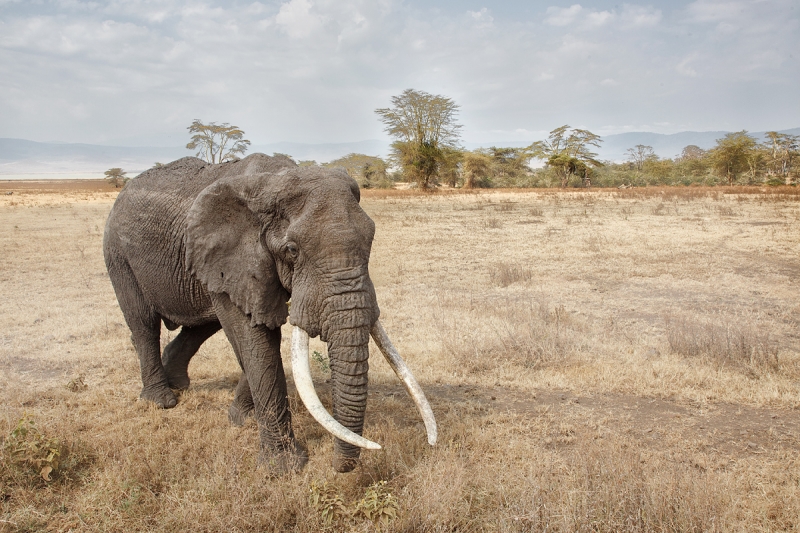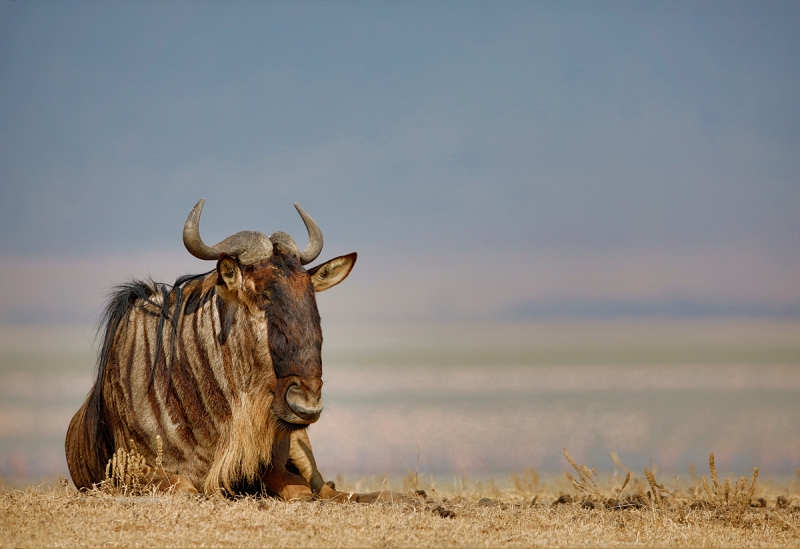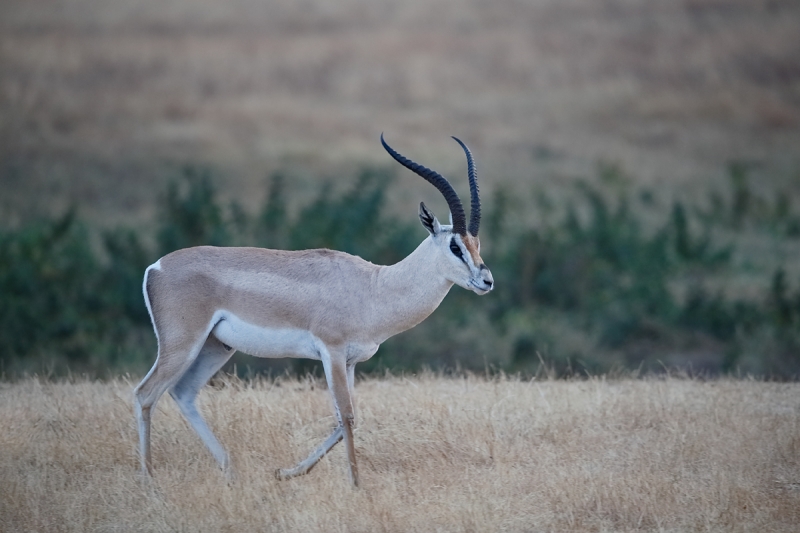|
This image was created with the Canon 24-105mm f/4L IS EF USM AF lens hand held at 32mm) and the Canon EOS 5D Mark III ISO 400. Evaluative metering +1 stop: 1/500 sec. at f/10. Two sensors to the left of the central sensor/AI Servo Rear Focus AF on the elephant’s mouth active at the moment of exposure. Click here if you missed the Rear Focus Tutorial. Be sure to click on the image to enjoy a larger version. |
Big Tusker
We saw this big African Elephant a long way off. With its 7 foot tucks, it stood out from the crowd. Patrick Sparkman was in my safari van. We were so enthralled with those huge tusks that though we were both experienced photographers we each made the mistake of making images of the animal with the 600II/2X III TC combination when the image was far far away on a hot dusty morning. With the heat shimmer, haze, and dust between us and our subject we deleted every image.
We waited patiently as the elephant walked steadfastly towards our van. When he angled away a bit while foraging, we had Niko back up the van about 100 meters. When the animal crossed the road it turned right, and headed directly towards us while munching on the large shrubs on the side of the road. When it was obvious that it would wind up right next to the van both Patrick and I grabbed the 24-105s, opened the side windows, and began making images. At one point I was wishing that I had my fish eye lens on!
|
This in-camera HDR Art Vivid image was created with the hand held Canon EF 200-400mm f/4L IS USM Lens with Internal 1.4x Extender (with the internal TC in place at 473mm) and the Canon EOS 5D Mark III. ISO 400. Evaluative metering +1 stop yielded a base exposure of 1/1600 sec. at f/5.6. Three sensors to the left and two rows below the central sensor/AI Servo Rear Focus AF on the Wildebeest’s face active at the moment of exposure. Click here if you missed the Rear Focus Tutorial. Click on the image to see a larger version. |
Down by the Lake with Willy the Wildebeest
After yesterday’s lion/hyena adventure (see here), and after creating the elephant image above, we came upon this rather regal-looking (if that is possible for a Bearded Gnu) Wildebeest. First, I photographed it from the top of the van, and then for the image above, got lower by working out of the opened side window with the hand held 200-400. I went to HDR Art Vivid to counteract the rather harsh light and getting low yielded a nice background of the lake with a smattering of flamingos.
|
This image was created with the hand held Canon EF 200-400mm f/4L IS USM Lens with Internal 1.4x Extender (with the internal TC in place at 473mm) and the Canon EOS-1D X. ISO 1600. Evaluative metering at zero: 1/125 sec. at f/5.6 in Tv mode+. Central sensor/AI Servo Rear Focus AF as framed active at the moment of exposure. Click here if you missed the Rear Focus Tutorial. Click on the image to see a larger version. |
Grant’s Wears the Pants
Grant’s Gazelle, the largest of the 3 common antelopes in East Africa, is easily identified by its white belly and its white inner leg linings, thus the “Grant’s wears the pants” tagline. All of the images in this and the previous blog post (mentioned above) were created on August 16, 2013 at Ngorongoro Crater on the Tanzania Summer Safari. Having the opportunity to photograph so many different large mammals in a single day is one of the great attractions of being on safari.
Image Questions
Why Tv mode in the soft, pre-dawn light?
Why make this image at zero in the soft predawn light when I would normally adding one full stop of light?
Your Favorite?
Which of the three images above is your favorite? Be sure to let us know why.
2014 Tanzania Summer Safari
2014 Tanzania Summer Safari, 14-day African Adventure/leave the US on August 9. Fly home on August 24: $12,999.
Co-leaders Todd Gustafson & Arthur Morris. Denise Ippolito will be added when 8 folks are signed up. The limit is 12. Three photographers/van; you get your own row of seats. Our trip is a bit more expensive than the average safari for good reason. It is the best. We have the best driver guides with a total of decades of experience. They have been trained over the years by Todd and by me to drive with photography in mind.We have the best and most knowledgeable leaders. We stay in the best lodges and camps. We hope that you will join us for what will be Todd’s 35th African safari, and my 8th.
If you are seriously interested please e-mail me; I will be glad to send you the illustrated PDF with the complete itinerary and deposit info.
What else makes this expedition unique?
•Pre-trip consultation and camera equipment advice
•Award-winning photographers as your guides
•A seamless itinerary visiting the right locations at the best time of year
•Hands-on photography instruction in the field
•Specially designed three rood hatch photo safari vehicles
•Proprietary materials for preparation, including free copy of “A Photographer’s Guide to Photographing in East Africa.”
•Post-safari image critiques
All-inclusive (double-occupancy) except for your flights to and from Kilamajaro Airport, bar drinks, soda & water (except at the Intimate Tented Camp where everything is free for our entire stay), tips for drivers and camp staff, personal items, and trip insurance.
Holland Heating Up
Pending the arrival of promised checks, we now have six folks for the Touch of Holland Tulip IPT. Click here and scroll down for details.
Bosque IPTs
For information on both the 7-Day and the recently announced short version of the 2013 Bosque IPTs please click here and scroll down.
Support the BAA Blog. Support the BAA Bulletins: Shop B&H here!
We want and need to keep providing you with the latest free information, photography and Photoshop lessons, and all manner of related information. Show your appreciation by making your purchases immediately after clicking on any of our B&H or Amazon Affiliate links in this blog post. Remember, B&H ain’t just photography!


Amazon
Everyone buys something from Amazon, be it a big lens or deodorant. Support the blog by starting your search by starting your search by clicking on the logo-link below. No purchase is too small to be appreciated; they all add up. Why make it a habit? Because I make it a habit of bringing you new images and information on an almost daily basis.
Typos
On all blog posts, feel free to e-mail or leave a comment regarding any typos, wrong words, misspellings, omissions, or grammatical errors. Just be right. 🙂

















My favorite of the shots has to be the elephant. Incredible detail so close.
To answer image question 1: TV mode to set a shutter speed fast enough (safety shift, auto ISO) to hand hold and use the in camera HDR mode.
For question 2, why use a zero exposure in soft morning light?
Answer: The overall exposure averages to a middle tone and the subject is lighter than middle tone. Adding exposure might wash out detail on the gazelle.
Hey Tom, You answer for #1 is correct. With #2, it was the dark bushes behind the gazelle that eliminated the need for +1 exposure compensation….